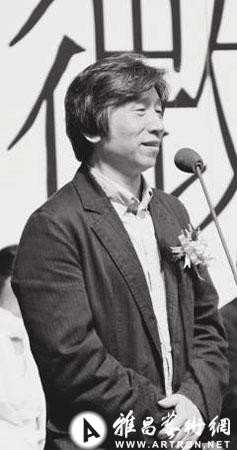
中国美术馆馆长范迪安2011年5月5日
我相信,所有走进这个展览的观众—无论是艺术界的同仁,还是热爱艺术的朋友—都会为这位艺术家,向我们奉献的这样一个大型个人展览所付出的巨量劳动而感动。胡明哲,这位女艺术家用喷涌而发的创造热情,不仅构筑出她在岩彩绘画创作上的恢弘景象,也实现了自己艺术人生的又一次升华。
胡明哲早先是一位工笔画家,和所有在改革开放时代思考并探索艺术创新课题的同代人一样,她也在继承传统的过程中不断追求自己新的学术目标。20世纪90年代初,她前往日本东京艺术大学研修,在研究日本绘画之时,她注意到“岩绘之具”这种天然矿物色的运用在日本画的创作和教学中所具有的广度和深度。“岩绘之具”不仅是日本画在媒介上的代名词,而且经过日本画家的传承与创新,实现了日本画从古典形态向现代形态的演变。在东瀛的所学使她获得了技巧;更重要的是,在异国的所识使她猛醒,“岩彩”的传统何尝不是源发于中国?在古代帛画、汉唐壁画以及后来的青绿山水及工笔人物中,何尝不显现着“岩彩”的光辉?她意识到:“岩彩”是个不寻常的媒介,具有深厚的中国文化基因和东方审美特性,作为一个中国画家,有责任将这传统发扬光大。从那时候开始,“复兴中国岩彩绘画”的理想激励着她在创作上投以持续的探索,她也成为中国岩彩绘画不遗余力的重要推动者。
心中有豁亮光芒,笔底便有不息光彩。胡明哲这些年沉浸在岩彩绘画的创作中,以岩彩为契机,展开了各种实验,几乎极尽所能。从承接载体的拓展到结合媒介的改良,从架上作品的描绘到壁画式、装置式作品的制作,其间投入的劳动强度难以想象。经过她的努力,岩彩质地的晶粒感和炫目的色彩美在各种形态的作品中绽放出来,让人看到岩彩语言在艺术表现上极为宽阔的可能性和丰富性。
在胡明哲的绘画中,我们看到的并不是一个已经消失的传统或一些远古世界的遗迹,而是一个当代艺术家的创造。她研究岩彩这种媒介语言的过程,也是自身艺术观念不断拓展的过程。语言与观念在她的艺术探索中相辅相成,互为促进,使她的艺术主题、表现内容和作品格局都发生了极大的变化。从物质的世界延伸到现实的世界,她的感觉和感怀与今日都市生活叠印在一起。
她把展览的主题命名为“微尘”,这也是她这些年感受都市流光溢彩、叹喟芸芸生命形态的总主题。“微尘”展览呈现给我们的是一个博大的世界,其中鲜明地透露出胡明哲的当代意识,以及一位女艺术家对现实的敏感与对生命悯爱的情怀。
用中国美术馆一个楼层的展厅空间举办个展,对艺术家来说是严峻的挑战。而胡明哲勇敢地迎接了这次挑战,使展览空间成为一个大型艺术与公共艺术的空间。她的展览让我们获得视觉上的震撼,更重要的是,让我们思考—立足于中国艺术本源和传统本质的当代创造。
I believe that the audience entering the exhibition ¨C no matter whether colleagues in art circles or art lovers - will all be moved by the huge labor that this artist has produced in this large solo exhibition. Hu Mingzhe, a female artist, shares her prolific exploration of rock-color painting, by presenting this exhibition to the world.
In the early days, Hu Mingzhe was a meticulous painter. Like many other Chinese artists of her generation who thought over and explored artistic innovation in the era of reform and opening up, she found a way to continually pursue her own new academic goals while also maintaining elements of tradition. In the early 1990s, she went to Japan and researched and studied at the Tokyo University of the Arts. When she was studying Japanese painting, she noticed the width and depth of this natural ore color in Japanese painting through "the tool of mineral color painting¡±. Through the Japanese artists¡¯ inheritance and innovation ¡°the tool of mineral color painting¡± has evolved from a classical form to a modern form of Japanese painting. What she has learned in Japan helped her to gain techniques, but more importantly, it abruptly awoke a realization that the tradition of ¡°mineral color¡± is originated from China. In the ancient silk painting, the murals in Han and Tang dynasties and later green landscapes and meticulous figure paintings reflected the brilliance of mineral color. She realized that ¡°mineral color¡± is an unusual medium and has a profound Chinese cultural gene and oriental aesthetic characteristic, and as a Chinese artist, she believed we had the responsibility to carry forward this tradition. Since then, inspired by the ideal of ¡°renaissance of mineral color painting¡±, she devoted persistent exploration to painting, and she has become an important figure in promoting Chinese rock-color painting.
Where there is bright radiance in the heart, there will be incessant glory. These years, Hu immersed in the mineral color painting¡¯s creation, built an opportunity for mineral color, started various experiments, and worked endlessly. From the expansion of the undertaken carrier to the improvement of combined media, from the depiction of works on the shelf to the production of works of mural and device type, the invested labor intensity is unconceivably hard. Through her efforts, mineral color¡¯s sense of crystal grain texture and glaring beauty of color bloom out in various forms of works. People could see the extremely broad possibilities and richness of mineral color language in artistic expression.
In Hu¡¯s painting, we can¡¯t see a tradition that has been lost or some remains of the ancient world, but a creation of a contemporary artist. The process that she studies the mineral color medium language, is also the expansion of her own artistic concepts. In her artistic exploration, language and concepts are complementary and mutually reinforcing, which make great changes in her artistic theme, content of performance and work pattern. From material world to realistic world, her feelings and recollections are all overlapped with the urban life today.
She named the exhibition¡¯s theme as ¡°Mote¡±, and this is also her general theme of experiencing urban gorgeousness during these years and sighing about all the living forms. The exhibition ¡°Mote¡± presents us a broad world, which clearly reveals Hu¡¯s contemporary consciousness, and a female artist¡¯s sensitivity to reality and sensitivity for the feelings for lives.
Holding exhibition by occupying a whole floor of National Art Museum of China¡¯s exhibition hall is a serious challenge to an artist. Hu faces this challenge with courage and changes it into a large, public art space. Her exhibition gives us a visual shock, more importantly, it makes us wonder - standing on the contemporary creation of Chinese art origin and traditional nature.
Fan Di¡¯an
Curator of National Art Museum of China
May 5, 2011
Copyright Reserved 2000-2025 雅昌艺术网 版权所有
增值电信业务经营许可证(粤)B2-20030053广播电视制作经营许可证(粤)字第717号企业法人营业执照
 京公网安备 11011302000792号粤ICP备17056390号-4信息网络传播视听节目许可证1909402号互联网域名注册证书中国互联网举报中心
京公网安备 11011302000792号粤ICP备17056390号-4信息网络传播视听节目许可证1909402号互联网域名注册证书中国互联网举报中心
网络文化经营许可证粤网文[2018]3670-1221号网络出版服务许可证(总)网出证(粤)字第021号出版物经营许可证可信网站验证服务证书2012040503023850号